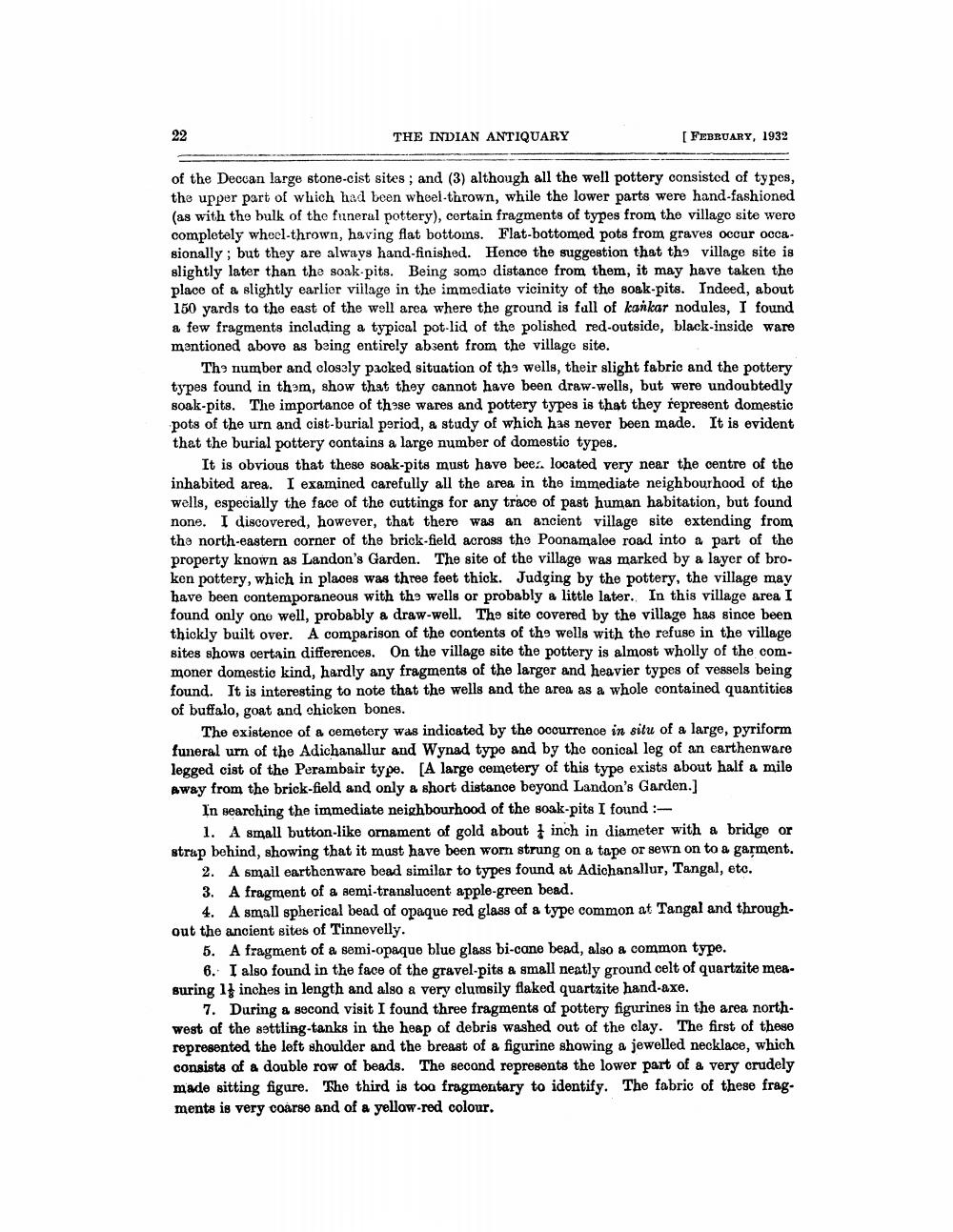________________
22
THE INDIAN ANTIQUARY
[ FEBRUARY, 1932
of the Deocan large stone-cist sites; and (3) although all the well pottery consisted of types, the upper part of which had been wheel-thrown, while the lower parts were hand-fashioned (as with the bulk of the funeral pottery), certain fragments of types from the village site were completely wheel-thrown, having flat bottoms. Flat-bottomed pots from graves occur occasionally; but they are always hand-finished. Hence the suggestion that the village site is slightly later than the soak pits. Being som distance from them, it may have taken the place of a slightly earlier village in the immediate vicinity of the soak-pits. Indeed, about 150 yards to the east of the well area where the ground is full of kankar nodules, I found a few fragments including a typical pot-lid of the polished red-outside, black-inside ware mentioned above as being entirely absent from the village site.
The number and closely packed situation of the wells, their slight fabric and the pottery types found in them, show that they cannot have been draw-wells, but were undoubtedly soak pits. The importance of these wares and pottery types is that they represent domestic pots of the urn and cist-burial period, a study of which has never been made. It is evident that the burial pottery contains a large number of domestic types.
It is obvious that these soak-pits must have bee.. located very near the centre of the inhabited area. I examined carefully all the area in the immediate neighbourhood of the wells, especially the face of the cuttings for any trace of past human habitation, but found none. I discovered, however, that there was an ancient village site extending from the north-eastern corner of the brick-field across the Poonamalee road into a part of the property known as Landon's Garden. The site of the village was marked by a layer of brokon pottery, which in places was three feet thick. Judging by the pottery, the village may have been contemporaneous with the wells or probably a little later. In this village area I found only one well, probably a draw-well. The site covered by the village has since been thickly built over. A comparison of the contents of the wells with the refuse in the village sites shows certain differences. On the village site the pottery is almost wholly of the commoner domestic kind, hardly any fragments of the larger and heavier types of vessels being found. It is interesting to note that the wells and the area as a whole contained quantities of buffalo, goat and chicken bones.
The existence of a cemetery was indicated by the occurrence in situ of a large, pyriform funeral urn of the Adichanallur and Wynad type and by the conical leg of an earthenware legged cist of the Perambair type. (A large cemetery of this type exists about half a mile Away from the brick-field and only a short distance beyond Landon's Garden.)
In searching the immediate neighbourhood of the soak-pits I found :
1. A small button-like ornament of gold about 1 inch in diameter with a bridge or strap behind, showing that it must have been worn strung on a tape or sewn on to a gaśment.
2. A small earthenware bead similar to types found at Adichanallur, Tangal, etc. 3. A fragment of a semi-translucent apple-green bead.
4. A small spherical bead of opaque red glass of a type common at Tangal and through. out the ancient sites of Tinnevelly.
5. A fragment of a semi-opaque blue glass bi-cane bead, also a common type.
6. I also found in the face of the gravel-pits a small neatly ground celt of quartzite measuring 1 inches in length and also a very clumsily flaked quartzite hand-axe.
7. During a second visit I found three fragments of pottery figurines in the area northwest of the settling-tanks in the heap of debris washed out of the clay. The first of these represented the left shoulder and the breast of a figurine showing a jewelled necklace, which consists of a double row of beads. The second represents the lower part of a very crudely made sitting figure. The third is too fragmentary to identify. The fabric of these fragments is very coarse and of a yellow-red colour.




